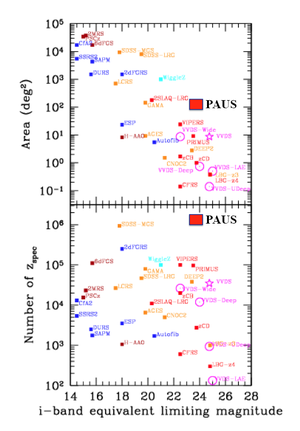“PAUS”的版本间差异
跳到导航
跳到搜索
(→PAUS) |
无编辑摘要 |
||
| 第14行: | 第14行: | ||
*a 100 deg2 PAUS with 45 color bands is equivalent to 4500 deg2 single band imaging survey |
*a 100 deg2 PAUS with 45 color bands is equivalent to 4500 deg2 single band imaging survey |
||
* Observe ∼100 deg2 to iAB ≈ 23-24 to reach a volume of 0.3-0.5 (Gpc/h)3 with a few million redshifts split into 3 to 4 wide fields (of several tens of deg2 each) |
* Observe ∼100 deg2 to iAB ≈ 23-24 to reach a volume of 0.3-0.5 (Gpc/h)3 with a few million redshifts split into 3 to 4 wide fields (of several tens of deg2 each) |
||
* where Broad-Band (BB) photometric measurements have already been obtained by CFHTLenS and KiDS, and in which spectroscopic redshifts for calibration are available from the GAMA, VIPERS, DEEP2 and zCOSMOS redshift surveys. |
* where Broad-Band (BB) photometric measurements have already been obtained by [[CFHTLenS]] and [[KiDS]], and in which spectroscopic redshifts for calibration are available from the [[GAMA]], [[VIPERS]], [[DEEP2]] and [[zCOSMOS]] redshift surveys. |
||
2016年1月8日 (五) 03:02的最新版本
PAUcam
PAUCam is an optical imaging camera to be used at the prime focus of the William Herschel Telescope (WHT).
- FOV 1 deg x 1 deg
- Pixel Scale 0.265″
- 18 Hamamatsu Fully-Depleted 4K x 2K CCD detectors
The camera is installed with 6 large ugrizY filters covering each the total focal plane and 5 trays containing 40 narrow band filters (10 nm) covering the range between 450-850 nm on the 8 central CCDs. Additionally, there is the possibility to install two external custom filters.
PAUS
- survey with PAUCam
- a 100 deg2 PAUS will provide 3 million redshifts to iAB>22.5 (30 times more than currently available)
- a 100 deg2 PAUS with 45 color bands is equivalent to 4500 deg2 single band imaging survey
- Observe ∼100 deg2 to iAB ≈ 23-24 to reach a volume of 0.3-0.5 (Gpc/h)3 with a few million redshifts split into 3 to 4 wide fields (of several tens of deg2 each)
- where Broad-Band (BB) photometric measurements have already been obtained by CFHTLenS and KiDS, and in which spectroscopic redshifts for calibration are available from the GAMA, VIPERS, DEEP2 and zCOSMOS redshift surveys.
